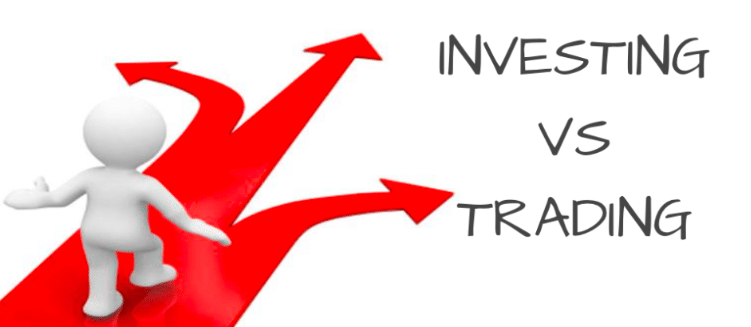Often times when we hear the term “forex market”, chances are that it is referring to the spot forex market. The Spot Forex market is the place where a trader buys or sells currency at the current price on the date of the contract for delivery within two business days.

There are many articles on the web that talk about how to invest or trade properly in the forex market. Even though these terms are used interchangeably in these contexts, the terms investing and trading have some important differences when it applies to the forex market. As a forex market player, you have to give thought to what each of the words entails and recognizes the differences between the two concepts. There are advantages for both and no one can quite say one is better than the other.
However, if you want to grow your wealth in the forex market, trading is usually the path forward.
Points of Difference
Timeframe
In the context of trading, the trader’s main goal is to profit from whatever direction the market goes. This can be either upward or downward within a shorter time frame. Even though there are both short-term and long-term trading techniques, the holding period for these rarely extends beyond more than a few months or longer than a year.
When it comes to investing, however, it usually entails the buy and hold concept. Here, the investor’s goal is to acquire a financial instrument and holding it for a medium to long-term. They do this with the hope that the financial instrument, will appreciate in value significantly over a certain period of time.
Value Ownership
Investors are concerned with acquiring the ownership of the financial instrument in question, with the confidence that the value of the said instrument will continue to appreciate. Thus, they tend to believe in the “buy low and sell high” philosophy. For instance, an investor may spot a particular stock that is going down in value. He/she can perceive it as a good opportunity to purchase and own the stock “cheaply” with the hope that they will profit when the stock price increases in the near future.
This concept is entirely absent in trading, which does not have much concern with buying and owning the instrument. They tend to exhibit the same ease with either short-selling or longing(buying) the instrument. Traders are more willing to purchase “high” in the hope of being able to sell even “higher”. They can also short sell “low” longing(buying) in the hope of being able to buy back later at an even lower price.
Getting In The Market
Investors who are serious have a tendency to purchase an instrument after considering the underlying fundamental reason. Savvy stock investors for example will analyze the background of a company. This includes taking a look at its quarterly earnings report, assess the potential of the company’s products, assess the company’s reputation and strength in a particular sector, and examining the track record of its management team.
On the other hand, traders look for high probability trade setups which they select after conducting technical analysis using their preferred tool. Many traders also incorporate market sentiment when making trading decisions. Short-term traders can quickly recognize changing market trends and take the necessary steps to take advantage of the price swings in the market, regardless of whether it’s a range-bound or a trending environment.
Getting Out Of The Market
The “buy and hold” mentality which the majority of investors have tends to turn into “buy and forget”. In other words, many investors almost have zero ideas about when to get out of their investments when things go south. Many investors who do not have stop-loss boundaries in place or do not know when to cut their losses almost always end up stuck with worthless stocks.
While it is true that there are many traders who do not have proper risk management rules in place, traders on the whole generally are more aware of risk management compared to investors. Whether or not these rules and considerations are applied by the trader depends on his/her practices and discretion.
Currency Analysis
When an investor analyzes a currency, it is usually part of a holding of currencies he or she has in their portfolio. Investors are not so concerned with the actual value of the currency going up and down, so long as the return from the portfolio is intact. They may adjust the losses from one currency pair by turning huge profits in another currency pair.
For traders, however, it is crucial to analyze currencies more carefully. Their main goal is to generate returns that outperform buy and hold investing. While investors may be satisfied with a 10% to 15% annual return, traders may seek the same returns on a monthly basis. Also, investors are not concerned with any downward movement of currencies, unlike traders who can profit from currencies, no matter what the direction.
Final Thoughts
The emergence of this new class of currency trading platforms has enabled speculators, traders, and investors to take advantage of the rapid fluctuations which exist in this market. Since traders put in money for the short-term in the forex market, they are at a more advantageous position compared to investors. This hands-on approach is what makes forex the ideal space for traders rather than investors.
However, one should always remember that the forex market has some inherent risks associated with it, with more than ninety percent of forex traders losing their capital. Whether one invests or trades, risk control is paramount.
The veil of mystery which existed over the forex market was mainly because it was controlled by a plethora of banks, hedge funds, financial institutions, and corporations where money was exchanged only for commercial and speculative purposes. However, with the wide availability of sophisticated technology, the forex space has expanded thanks to the emergence of online currency trading platforms.
Many such platforms provide free charting software, real-time news feeds, and user-friendly order placing systems.








Leave a Reply